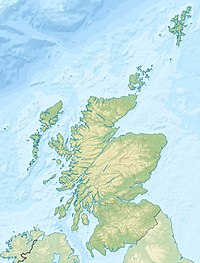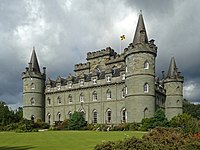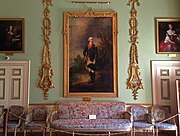| Inveraray Castle | |
|---|---|
| Inveraray, Argyll, Scotland, United Kingdom | |
 Inveraray Castle in 2014 Inveraray Castle in 2014 | |
| Shown within Scotland | |
 | |
| Coordinates | 56°14′15″N 5°04′25″W / 56.2374808°N 5.0735762°W / 56.2374808; -5.0735762 |
| Grid reference | grid reference NN095092 |
| Site information | |
| Open to the public | Yes |
| Site history | |
| Materials | Stone |
| Events | |
| Website | www |
| Listed Building – Category A | |
| Designated | 20 July 1971 |
| Reference no. | LB11552 |
Inveraray Castle (pronounced /ˌɪnvəˈrɛərə/ invə-REHRUH or /ˌɪnvəˈrɛərɪ/ invə-REHREH; Scottish Gaelic Caisteal Inbhir Aora [ˈkʰaʃtʲəl̪ˠ iɲɪɾʲˈɯːɾə]) is a country house near Inveraray in the county of Argyll, in western Scotland, on the shore of Loch Fyne, Scotland's longest sea loch. It is one of the earliest examples of Gothic Revival architecture.
It has been the seat of the Dukes of Argyll, chiefs of Clan Campbell, since the 18th century.
History and architecture
James V stayed at the old castle of Inveraray in September 1533. A new lute was bought for him in Glasgow and carried to Inveraray by his servant Troilus.
The present castle was built in the Gothic Revival style. Improvements on the estate began in 1743 by Archibald Campbell, Earl of Ilay, soon to become 3rd Duke of Argyll. The foundation stone of the new castle was laid in October 1746, and it replaced an earlier 15th-century castle.
It is one of the earliest Gothic Revival buildings, together with Strawberry Hill House. It was built of ashlar lapis ollaris. Originally, all the roofs were flat and crenellated. Later, a third floor with pitched roof and dormer windows was added on all four wings, and steep conical roofs were added to the four round towers. In the 1770s, the village of Inveraray was demolished and rebuilt a short distance away, to give the castle a more secluded setting.
Designers who worked on the new castle include William Adam and Roger Morris. The interior has a number of neoclassical rooms created later in the 18th century for the 5th Duke by Robert Mylne. These are among the rooms open to the public. James Lees-Milne was not impressed by the house when he visited it in 1943, noting the "ugly" grey stone and calling it "grim and forbidding".
In 1975 a devastating fire struck Inveraray and for some time the 12th Duke and his family lived in the castle's basement, while restorations were carried out, funded by a worldwide fundraising drive.
Modern era
The castle is open to visitors. Its collection includes more than 1,300 pikes, muskets, swords and other weapons. Torquhil Campbell, 13th Duke of Argyll and his family live in private apartments occupying two floors and set between two of the four crenellated circular towers. Recent renovations included the installation of the house's first central heating system, powered by burning wood-chips from the family's forestry holdings. It was previously heated only by open fires.
Inveraray Castle is a Category A listed building. It is surrounded by a 16-acre (6.5-hectare) garden and an estate of 60,000 acres (24,000 hectares). Besides welcoming visitors to the castle, the estate's activities include commercial forestry, tenanted farming, wind and hydro power, and deer stalking.
In popular culture
The castle has featured in a number of media productions including: Downton Abbey (2012); Great Estates Scotland (2014); and Susan Calman's Secret Scotland (2020). The "Best of the West" festival, organised by the Duchess, was held at the castle each September until 2018. Other productions included An American Aristocrat's Guide to Great Estates, the BBC miniseries A Very British Scandal, and The Diplomat (2024).
The castle is reputedly haunted.
Inveraray exteriors-
 A lithograph of Inveraray Castle, 1880
A lithograph of Inveraray Castle, 1880
-
 Panoramic view of Inveraray setting
Panoramic view of Inveraray setting
-
 View from the garden
View from the garden
-
 Facade on the garden
Facade on the garden
-
 Close view of the façade
Close view of the façade
-
 Inveraray interior great hall
Inveraray interior great hall
-
 Inveraray interior
Inveraray interior
-
 Inveraray interior detail
Inveraray interior detail
-
 Inveraray interior sitting room
Inveraray interior sitting room
-
 Inveraray interior dining room
Inveraray interior dining room
-
 Inveraray interior kitchen
Inveraray interior kitchen
References
- ^ Matthew Dennison (14 July 2011). "Inveraray Castle: home to the Duke of Argyll". The Daily Telegraph. Archived from the original on 14 July 2011. Retrieved 24 May 2012.
- James Balfour Paul, Accounts of the Treasurer, vol. 6 (Edinburgh, 1905), p. 87.
- ^ Coventry, Martin. (2008). Castles of the Clans: The Strongholds and Seats of 750 Scottish Families and Clans. pp. 76–87. ISBN 978-1-899874-36-1.
- ^ Historic Environment Scotland. "Inveraray Castle (LB11552)". Retrieved 15 April 2019.
- ^ Dickie, Mure (8 August 2015). "Scottish peer with a clan-do attitude". Financial Times. p. 2.
- "The Duke of Argyll". The Daily Telegraph. 23 April 2001. Archived from the original on 12 January 2022. Retrieved 24 May 2012.
- "An American Aristocrat's Guide to Great Estates Season 1". Radio Times.
- "An American Aristocrat's Guide to Great Estates: Inveraray Castle (Full Episode)". Archived from the original on 14 May 2020 – via www.youtube.com.
- "A Very British Scandal".
- Hatchett, Keisha (2 November 2024). "Where is The Diplomat Filmed? Your Guide to the Season 2 Locations". Netflix. Retrieved 16 December 2024.
- Alexander, Marc (2012). In search of Britain's haunted castles. Paul Abrahams. Stroud: The History Press. ISBN 978-0-7524-7789-3. OCLC 793166081.
External links
- Its page in the Gazetteer for Scotland
| Clan Campbell | |
|---|---|
| Branches | |
| Lands | |
| Castles | |
- Castles in Argyll and Bute
- Category A listed buildings in Argyll and Bute
- Clan Campbell
- Clan Campbell seats
- Country houses in Argyll and Bute
- Mock castles in Scotland
- Gardens in Argyll and Bute
- Historic house museums in Argyll and Bute
- Inventory of Gardens and Designed Landscapes
- Listed castles in Scotland
- Reportedly haunted locations in Scotland